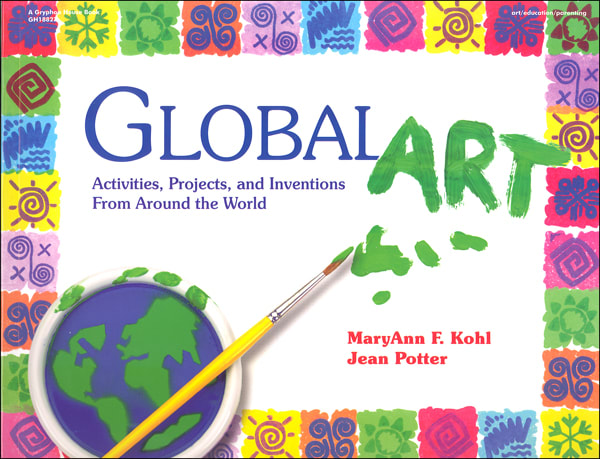Global Art is a great book to have on hand for use alongside unit studies or world cultures or geography courses. It has more than 130 arts and crafts projects arranged in units by continents. Within each unit, activities are generally presented by countries or people groups. You can pull out these activities as you teach about each place or people. Be aware that if you use the book sporadically like this, it is easy to forget about it over time. You might want to plan ahead and make notes about how and when you intend to use different activities rather than forgetting to use it at the appropriate times.
While the publisher recommends Global Art for grades three to six, many activities seem well suited to six- and seven-year olds. Each activity has one, two, or three stars to indicate the level of difficulty. Activities also have a number code from “1” to “3” indicating how much preparation work is required.
Activities range from the very simple—e.g., modeling with beeswax and printing with various size corks—to paper making, making papier maché pinatas, and cooking dough to create beads for a necklace. More than 80% of the activities have one or two stars, so I would definitely recommend this most highly to families with children in the early elementary grades since they will likely get the most use from it.
A variety of art media are used for drawing, painting, sculpture, collage, printing, face painting, paper cutting, and all sorts of other projects. Six different indexes help you locate just the right project; these indexes are: Art Medium Index, Experience Level Index (how many stars), Preparation Index (the numbers “1” through “3”), an Index of Terms and Materials (e.g., acetate, acrylic paints, cookie cutters, craft sticks, dancing, dowel, duct tape, hula hoop, and sewing trims), an Index of Activities by Country or Continent, and an Alphabetical Activity List.
Each project is presented on one page of the book with the rare activity extending to two pages. An image of a globe shows the general location of the country, people group, or continent represented by the craft activity. There’s a brief “Did you know?” paragraph next to the globe that makes the cultural connection between the activity and its source. A list of materials and step-by-step instructions are accompanied by an illustration of the project. Sometimes there is an additional idea or a variation that children might try.
Activities have been designed so that you do not need expensive equipment or too many unusual resources. For example, for paper making, Global Art uses pieces of screen, a towel, and a can rather than handmolds and screens; they also make a modified form of batik using a paste made from flour and water rather than wax and food dyes rather than real cloth dyes. Creating the piñata is probably one of the most challenging and time-consuming projects. A few projects require resources such as self-drying craft clay, liquid starch, natural materials (e.g., seeds, leaves), alum, or an old inner tube from a tire. So you do need to decide ahead of time which activities you might use and collect whatever you need.
Each activity makes a connection to a culture, but you might want to expand on some of the connections beyond what is in the book. Examples of some of the connections are the Antarctica Snow Scene representing the weather in Antarctica, the Maple Leaf Print for Canada, face painting for the Southeast Nuba people of the Sudan, handmade paper for China, a story banner for the Hmong people of Cambodia, Scarab Stones for Egypt (from ancient times), and edible Koala Treats for Australia. Some of the connections really stretch from the original idea; the Fancy Eyeglasses activity has children decorate an old eyeglass frame with beads, jewels, feathers, and glitter to make a connection to the Roman emperor Nero who was purportedly the first to discover that “a precious stone mounted on a ring could act like a magnifying glass” (p. 91). While there are some connections to cultural religious rites, there are no mentions of Christianity, Judaism, or Islam. Even though there are a few activities such as the Swedish Straw Ornament that relates to Christmas, those activities are never connected to religious beliefs or meaning.
Global Art is not really an art curriculum, although children do become familiar with various art media through the projects. The approach is more crafts than art. The book is well summed up by the authors who say, “The projects in Global Art allow children to explore the world through art with a process, not a product, approach to artistic outcome. In other words, it is the process of exploring and creating, rather than the finished product that is most important for the young artist. The activities leave room for the artist to use imagination and exploration, keys to creativity” (p. 8).
Some activity ideas are impressive while others are ho-hum. Even those that are less exciting are likely to be fun for younger children. In the end, you are unlikely to use all of the activities, so choose those that you know your own children are likely to enjoy.









